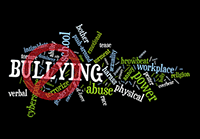Bullying of Children

Go to the PDP Menu
NASET Series: Bullying of Children
Bullying is unwanted, aggressive behavior among school aged children that involves a real or perceived power imbalance. The behavior is repeated, or has the potential to be repeated, over time. Bullying includes actions such as making threats, spreading rumors, attacking someone physically or verbally, and excluding someone from a group on purpose.
Cyberbullying is bullying that takes place using electronic technology. Electronic technology includes devices and equipment such as cell phones, computers, and tablets as well as communication tools including social media sites, text messages, chat, and websites.
There are many roles that kids can play. Kids can bully others, they can be bullied, or they may witness bullying. When kids are involved in bullying, they often play more than one role. It is important to understand the multiple roles kids play in order to effectively prevent and respond to bullying.
No single factor puts a child at risk of being bullied or bullying others. Bullying can happen anywhere—cities, suburbs, or rural towns. Depending on the environment, some groups - such as lesbian, gay, bisexual, or transgendered (LGBT) youth, youth with disabilities, and socially isolated youth—may be at an increased risk of being bullied.
Parents, school staff, and other caring adults have a role to play in preventing bullying. They can:
- Help kids understand bullying. Talk about what bullying is and how to stand up to it safely. Tell kids bullying is unacceptable. Make sure kids know how to get help.
- Keep the lines of communication open. Check in with kids often. Listen to them. Know their friends, ask about school, and understand their concerns.
- Encourage kids to do what they love. Special activities, interests, and hobbies can boost confidence, help kids make friends, and protect them from bullying behavior.
- Model how to treat others with kindness and respect.
NASET’s new series on Bullying of Children will cover many different topics on the importance of bullying, how it impacts children with disabilities and what we can do to prevent bullying in and outside of the schools.
Latest and Archived Issues
Issue #10
- Student Reports of Bullying: Results from the School Crime Supplement (SCS) to the National Crime Victimization Survey (NCVS)
Issue #9
- Becoming a Teacher Ambassador to Combat Bullying of Students with Special Needs in an Elementary School Setting
Issue #7
- Bullying and Teasing of Youth with Disabilities: Creating Positive School Environments for Effective Inclusion